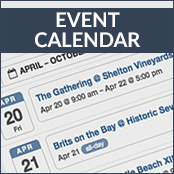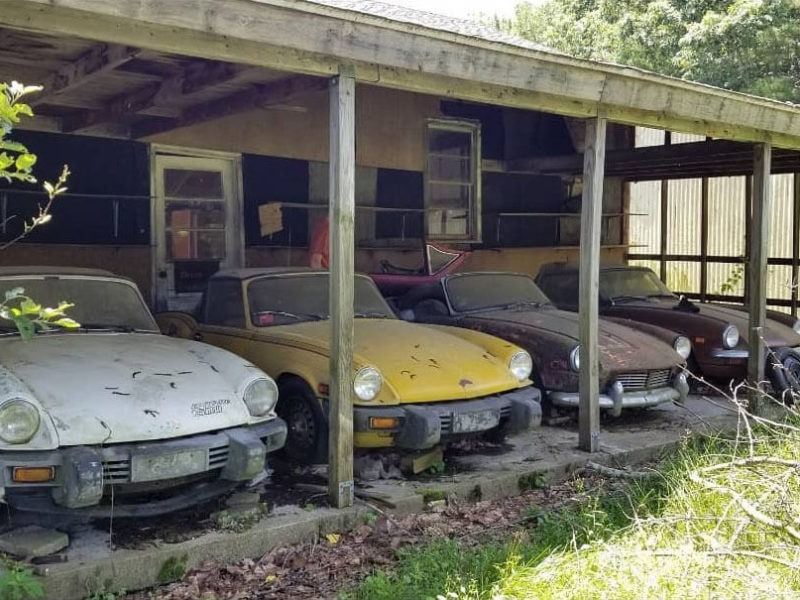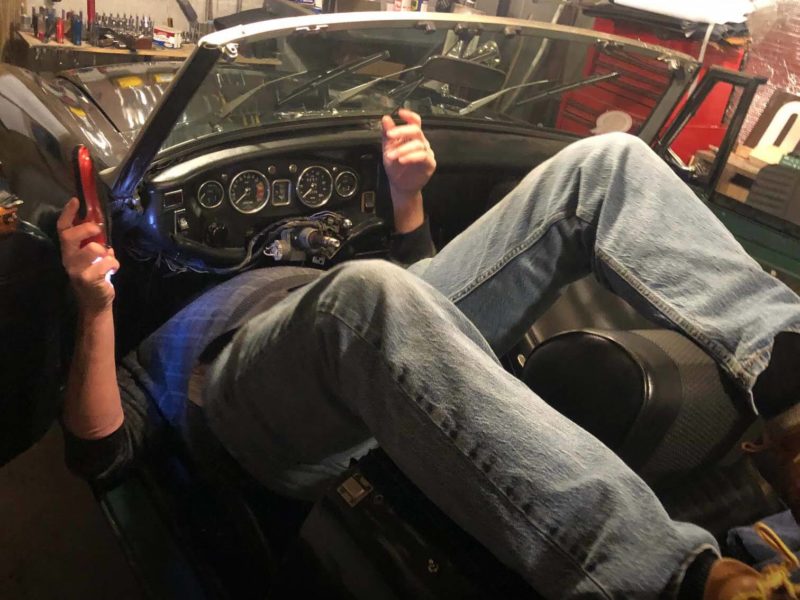The free lunch may be a myth, but I have found a true cheap lunch! It comes in the form of a cheap and relatively easy fix to what often sounds like a very expensive problem with the MGB rear axle. Both Lindsay Porter’s MGB Guide to Purchase if DIY Restoration, as well as the Moss MGB catalogue (version MGB-II) mention a repair for the “chink” that develops in the MGB tubed-type rear axle after many years of normal use. In the case of my 7475 ‘B, it was at about 65,000 miles that I decided something was amiss. At 80,000 miles I made the decision to take corrective action and bought the recommended thrust washers (two each of#267-140 and #267-130, ref. #65 and #67 on page 31).
Now at 85,000 miles, after carrying the replacement parts with me in a move from California to Copenhagen, Denmark, for three years and back to California, I got up the gumption to break into the mysteries under the rear axle cover plate. Rest assured if this is the problem, the parts are only a few dollars—the challenge is opening the mysterious rear axle cover plate and actually extracting the machined gears and worn thrust washers within.
The repair job is recommended by both Porter and the Moss catalogue tip as being quite simple, but as a normal shade tree mechanic I have always held in awe the machine shop to which I was wisely referred for any work within the magical rear axle unit. It was actually Porter’s book, a wonderfully written guide for a complete MGB rebuild, that gave me the confidence to proceed.
The purchase of my copy of the book is a story in itself, having been “discovered” in a car parts store in Salisbury, UK, during a business trip long before I saw it offered in the Moss catalogue. While my normal Haynes repair manual is quite comprehensive, I am never certain if I have translated the British correctly into American, or that I have correctly reinterpreted from the basic focus of the Haynes manual on earlier British models to the appendix chapter on later changes which always seem to apply to my 74V model. I will use both Haynes’ and Porter’s British as well as Moss catalogue terms for parts throughout this article.
I refer you to Porter for pictures and a more detailed description, but I will cover the repair in sufficient detail to complete without his help. I begin by emphasizing a “gotcha” left out of both the cited guides—that being removal of the pinion pin (part #267-115, Moss ref. #69, page 31) from the differential cage.
If possible, drive your MGB to a shop that will steam clean the rear axle cover plate area, or as an option take it to a coin-operated car wash to clean the area. This will save much hand cleaning with rags and a putty knife (or oilier blunt instrument) if you remove the cover plate before cleaning. Drain the rear axle oil and remove the rear axle cover plate using caution, with the brake line affixed to two of the attachment studs. Also note the correct orientation of the handbrake line mount.
The first internal step is to remove the roll pin (Moss nomenclature—pinion pin peg) which holds the pinion pin in place, with a suitably sized punch. I successfully used a nail with the point ground flat because my punch was not long enough to drive the roll pin completely through the pinion pin.
The next step, removal of the pinion pin, is where caution is advised. The pin must be “drifted” out of the differential cage as described by Purler. He does not indicate a preferred orientation but I advise to drive it out in the direction of the end with the roll pinhole. The protrusion of the end with this hole will come in handy later in gripping the pinion pin to pull it out during the final stage of removal.
My primary caution is to avoid driving the pinion pin so far through the differential cage that the cage cannot be rotated to grip the protruding end of the pin and pull it out in the later stages of extraction. If one drives the pin beyond about ‘/5″-‘/r extension through the differential cage (depending on the exact orientation one chooses), the pin can restrict the rotation of the cage so the protruding end of the pin faces to the front of the rear axle case rather than to the rear opening.
If this should occur, one would be faced with the necessity of pulling the pin back into the differential cage, but being unable to achieve purchase on the pin in any way to do so. The resulting condition could require complete removal of both axle half shafts and extraction of the entire differential cage from the case, a task which is cautioned as a job for a shop with the special tool required to “stretch” the case to allow said removal.
USE CAUTION! Be sure you understand the geometry of this procedure before driving the pinion pin through the differential cage. Rotate the cage several times to observe this potential problem. This is not to invoke scare tactics; the procedure can be accomplished easily if fully understood. My experience was the pin can best be driven through the differential cage when the cage is rotated so the drilled end of the pin extends down and forward. The pin can be drifted out through the differential cage in this position using a short drift pin (3″-4″ long) until the roll pin hole protrudes from the differential cage. Proceed slowly to be sure the pin is not driven further through the differential cage than will allow complete rotation of the cage.
This is necessary for the protruding end of the pinion pin to face to the rear opening of the differential housing as described above. When sufficient extension of the pinion pin is achieved so the roll pin hole is completely accessible, rotate the differential cage so the extending pinion pin faces the rear. At this point a metal pin (I used a hardened concrete nail of suitable diameter) can be inserted through the roll pin hole as a gripping point for vise grips to man-handle the pinion pin out of the differential cage by pulling and twisting. I tried a normal nail first, but kept twisting it off with the vise grips as I twisted, turned, and pulled on the pinion pin. Porter describes this removal with only pliers but my experience is that gripping a smooth, hardened, and oily metal pin with pliers can be difficult. You are cautioned to wear gloves for this operation because there arc many sharp, hard edges in the vicinity which will batter unprotected knuckles.
As advised by both the Moss catalogue tip and Porter, the final removal of the sun gears (Moss—differential gears) which are splined onto the axle half shafts requires at least partial removal of one axle half shaft. I selected the left axle merely because it was convenient in my garage. This proved fortuitous because the required disconnection of the hand brake cable from the left brake back plate got the cable completely out of the way of the subsequent work on the rear axle. The right side would have allowed adequate movement of the right axle half-shaft, but the brake cable would have remained in the way of subsequent work.
This is a good time to disassemble, clean, and lubricate the hand brake compensating lever, likely frozen and ineffective in its job. Although not addressed in either the Porter or Moss catalogue, removal of the axle half shaft means removing the complete brake back plate and the mounted brake slave cylinders, brake shoes, etc. I found that with care, I could remove the four bolts which hold the brake back plate and bearing cap and carefully raise the complete brake back plate assembly up out of the way to work on pulling the axle half shaft.
Use caution to not kink the brake line, which is the sole connection of the brake back plate assembly with the car. I thus avoided opening a brake line with the subsequent complications of bleeding, cleaning, etc. Tap, twist, and remove the hub bearing cap. Complete removal of the half shaft was not necessary; I found that pulling the outer wheel bearing about halfway out of its mount was sufficient to allow removal of the sun gears within the differential cage one at a time. This avoided having a loose bearing to contend with and keep clean.
Of course, if an outer wheel bearing replacement is needed, this is a good time to complete the job. In any case, a new rear wheel bearing seal should be installed. A word on this pulling job: I was able to use the driving plate (Moss—hub extension) as a sort of impact puller. I first removed all the various parts of the axle (axle nut, axle shaft collar, driving plate, oil sealer collar, hub bearing cap) from the end of the half shaft. I then replaced the driving plate on the spline and installed the axle nut. The driving plate will now slip in and out a few inches on the axle half shaft splines by hand, allowing its use as an impact puller against the axle nut. This will work, assuming the axle splines are clean, allowing free slippage of the driving plate and the outer wheel bearing isn’t hard frozen in its mount. This is a fairly inefficient puller, but so simple, it is worth the effort to make the attempt.
Porter suggests a more robust method, which involves mounting a spare brake drum in the reversed position on the driving plate secured with the axle nut to allow brute-force hammering on the drum to extract the shaft-hearing combination. Porter’s caution is to avoid using a brake drum, which will be returned to service—the hammering could cause hairline cracks, which would be disastrous if it failed during subsequent driving.
The remainder of the procedure is quite simple, entailing normal practices of cleanliness and pre-lubrication of all bearing and gear surfaces (I used normal chassis grease), appropriate anti-seize on splines, and sealant on gasket areas.
This sounds complex, but is actually quite simple to complete. The time involved is concentrated on cleaning the area beforehand (this is the messiest part of a car, especially after 80,000 miles), removing the rear axle cover plate, cleaning all parts of the rear axle, removing and replacing the axle half shaft, etc. With appropriate cautions on removing the pinion pin, the removal/replacement of gears and thrust washers is remarkably simple. The result is lighter-sounding motoring, especially in stop-and-go traffic, which involves accelerating and decelerating.
Happy motoring!







'Curing the Dreaded Clunk' have 3 comments
April 22, 2019 @ 2:18 pm Tyler Irwin
This article did not address the repair of the “clunk” at all, only the preliminary steps of the process. Some mention for the reason for the “clunk” would have also been helpful. There are several more steps before the process is completed, including fitting the correct shims (and what size shims are required), and checking clearances with a zero gauge and feeler gauge.
January 13, 2020 @ 2:26 am steve livesley
I have added a video of how bad my diff thrust washers had worn on my blog at https://mgb.tips/2020/01/09/that-diff-is-def-worn/
When I removed the gears the thrust washers had completely worn away apart from one wafer thin copper washer. Car has done about 150k miles.
February 6, 2020 @ 9:36 am Clive Walters
How did you resolve the problem. I have just fitted new washers and still have some play but nowhere near as much as you. Is some play permissible? I don’t want to put it all back together only to have to take it apart again as fitting the gears back in to line up the pin was a real pain.